Herman Cahyo, Endah Kurnia, Agus Lutfi, Duwi Yunitasari, Fivien Muslihatin
Faculty of Economics and Business, University of Jember, Jember, Indonesia
Correspondence to: Herman Cahyo, Faculty of Economics and Business, University of Jember, Jember, Indonesia.
| Email: |  |
Copyright © 2022 The Author(s). Published by Scientific & Academic Publishing.
This work is licensed under the Creative Commons Attribution International License (CC BY).
http://creativecommons.org/licenses/by/4.0/

Abstract
This research aims to investigate the function and role of BUMDes as an economic engine in Jember Regency's rural areas. The role of BUMDes is analyzed from an economic, social, and political standpoint as well as from a legal and institutional, infrastructure, and institutional standpoint. Because the role is anticipated to grow into a stand-alone company and act as an economic engine for Jember Regency's rural districts, its viability is crucial. According to the findings of the BUMDes analysis, the rural area's multidimensional sustainability status index value falls into the moderately sustainable category. This demonstrates that all of the BUMDes' dimensions—including the economic, social, legal, and institutional ones, as well as the infrastructure and technological ones—have an impact on the sustainability of the system's role as a regional economic driver. The sustainability functions is influenced by the dimensions. Comparing the economic dimension to other dimensions, BUMDes (social, legal, and institutional, infrastructure and technology). The economic dimension in Jember Regency has the highest functional sustainability index value and a significant chance to raise the position of sustainability as an economic driver there. In the future, sensitive features or those that have an impact on the BUMDes function's sustainability status will have to be improved. On the other side, enhancements to non-sensitive qualities so that sensitive attributes' sustainability status can be raised Prioritizing the development of infrastructure, technology, and legal and institutional aspects of sustainability that have lower sustainability index values is necessary. In the meantime, the future value of the sustainability index can be improved or maintained in terms of its economic and social dimensions.
Keywords:
Sustainability of BUMDes Function, Index Multidimensionalonal (MDS)
Cite this paper: Herman Cahyo, Endah Kurnia, Agus Lutfi, Duwi Yunitasari, Fivien Muslihatin, Village Owned Business Enterprises (BUMDesa) as Economic Drivers in Rural Area in Jember Regency, American Journal of Economics, Vol. 12 No. 3, 2022, pp. 57-67. doi: 10.5923/j.economics.20221203.02.
1. Introduction
The goverment's efforts to strengthen the economic structure in rural areas have not been successful enough. One of the most important issues is that there is too much government intrusion, which prevents rural communities from using their ingenuity and invention to manage and operate the local economic engine. Rural communities' ineffective economic institutional systems and mechanisms have consequences for dependence on government support, eliminating the spirit of independence.The government's strategy for rural area development, as outlined in Law Number 6 of 2014 on villages, demonstrates the need to create an institutional economy in rural residents' lives. Rural areas are those where agriculture is the primary economic activity, along with the management of natural resources, and where there are also rural villages, public utilities, social services, and commercial enterprises.The local authority has not previously placed a high priority on community empowerment and assistance from the government in managing different economic potentials for the welfare of the populace and village development. While Law Number 32 of 2004's Articles 213 concerning village-owned enterprises (BUMDes) and 214 concerned village cooperation can serve as the foundation for and source of funding for initiatives aimed at empowering rural communities Increased welfare is typically the goal of community empowerment as a process of enabling and empowering the community. In this instance, the process of empowerment and independence is not accomplished by assisting village communities in managing the economic potential that exists in their village (Kartasasmita, 1997).Village-Owned Enterprises (BUMDes), which operate a variety of companies according to the potential of the village, serve as a tool for local economic empowerment. The goal of realizing this potential is to increase the villagers' economic well-being through the growth of business ventures. Additionally, the presence of BUMDes affects the growth of villages' primary sources of income (PAD), enabling villages to carry out development and enhance welfare more effectively. In reality, BUMDes was a social organization that supported the needs of the neighborhood by contributing social services. However, BUMDes is also a commercial institution where BUMDes aims to make profits through the sale of goods or services intended for the community (Adawiyah, 2018).The management of Village-Owned Enterprises (BUMDes) must be aware of the values upheld by the neighborhood in order for their commercial operations to complement the local environment. The most crucial requirement for Village Owned Enterprises (BUMDes) is money or business capital to carry out their operational activities. This is in addition to the values espoused by the local community. The business capital that BUMDes has access to can have a trickle-down effect, which means that it can fund all of the planned forms of productive activity that will grow household income and Village Original Income. Andrian Dolfriandra Huruta; 2016).Furthermore, Diartho, HC, the study's findings demonstrate how the size and breadth of the company have a significant impact on the sustainability of BUMDes. In comparison to BUMDes that originated as a result of top-down government intervention, BUMDes that operate internal businesses that cater to the needs of local residents (such as basic necessities, hand tractor rental) and BUMDes that grow from social solidarity and local wisdom are much stronger and more sustainable. This is because the resilience and sustainability of BUMDes are significantly influenced by local wisdom, which is connected to the abundance of social and political capital (Diartho, Herman Cahyo, 2017).Village Owned Enterprises (BUMDesa), whose development is based on the potential it has to enhance the economy of its people, especially in rural regions, are one way that Jember Regency is expanding the notion of rural area development through community empowerment. According to territoriality, the Village-Owned Enterprises (BUMDesa) investigated included BUMDes in agricultural (lowland), coastal, and highland areas (forests). The regional personality serves as a metaphor for the Jember Regency.The impressive showing of BUMDes as a growth driver for rural communities in Jember Regency is the result of numerous internal and external barriers. This study intends to define the tactics required to develop into an independent business entity and function to support the economy of rural areas in Jember Regency and explain howfunction continuity BUMDes, which are viewed from the economic, social, and political dimensions.
2. Literature Review
2.1. Reinventing Government Theory
The idea of public bureaucratic change has essentially been around since the 1980s, when theorists like Hood and Pollitt introduced it as a critique of how the old bureaucracy (Weberian model) had performed and had fallen short of society's expectations as well as shifts in the strategic environment. According to David Osborne and Ted Gaebler, the industrial-era government structure—characterized by a slow, centralized bureaucracy, adherence to rules and regulations, and a hierarchical line of command—no longer functions effectively. They (the government bureaucracy) bloat and become inefficient and wasteful. And as the world changes, they are unable to adapt to it.The idea behind the Reinventing Government movement is to allow government an entrepreneurial mindset. It's crucial for a government to be entrepreneurial if it wants to use resources effectively, creatively, and in response to the needs of its citizens. Only if the government gets rid of the temperament and mindset of the bureaucrats who have been straddling it will it be able to foster an entrepreneurial spirit. Decentralized, organic-adaptive, competitive, anticipatory, and participation processes replace the government bureaucracy's centralized, hierarchical, monopolistic, reactionary, and formalistic traits (Dwiyanto 1996). Osborne (2005) offers the following ten techniques to become a bureaucracy-entrepreneur:1. The government as a policy maker should be more of a guide than an implementer. For example, working with the private sector in collecting taxes, but the determination of taxpayers and the amount of tax levy is still carried out by the government.2. The government as the property of the community must empower the community more than continuously serve the community. One of the efforts is to urge the community to be able to take care of the safety of their own environment.3. The government as an institution in the realm of competition must inject the spirit of competition into its apparatus and service organizations. For example, by providing opportunities for the private sector to handle matters monopolized by the government, such as drinking water, electricity, and telephones.
2.2. Socio Entrepreneurship Theory
JG Dees is a person who is regarded to as a species in the entrepreneurial genus and who possesses a guiding spirit and a social entrepreneurial spirit—that is, the spirit of adding value to society by using entrepreneurial principles. In general, social entrepreneurship is not just confined to charitable work done by a firm through Corporate Social Responsibility (CSR) initiatives or by other charitable organizations (Dees, 1998).A word derived from entrepreneurship is social entrepreneurship. a word formed by combining the words "social," which means "community," with "entrepreneurship," which means "business." A social entrepreneur is someone who recognizes social issues and applies business talents to bring about social change, particularly in the welfare, education, and health sectors (Cukier, 2011).Socio-enterprises' major objective is to produce excellent social value for their clients. While a socio-entrepreneur seeks out creative solutions to ensure that his business will have access to the resources needed as long as they can generate social value, the ability of an entrepreneur to obtain resources like capital, labor, equipment, and others in a market competition is a good indication of the operation of a productive business (Mort, 2003).Social entrepreneurship and social innovation are closely connected concepts. A social entrepreneur's ability to identify possibilities, enhance systems, develop novel strategies, and come up with solutions for better environmental changes depends on their ability to innovate socially (Widiastusy, 2011). As long as they can generate social benefit, a social entrepreneur seeks out novel ways to guarantee that his or her company will have access to the resources it needs (Mort, 2003).According to Palesangi (2012), social entrepreneurship consists of four basic components: social values, civil society, innovation, and economic activity. The most defining characteristic of social entrepreneurship is the creation of tangible social benefits for the society and the environment (2). Public Sector Typically, social entrepreneurship results from the initiative and involvement of civil society by maximizing the social capital already present in the community and (3). Innovations. By fusing local knowledge and social innovation, social entrepreneurship, among other things, finds novel solutions to social issues.One type of entrepreneurship that seeks to benefit the community is known as social entrepreneurship. Although social entrepreneurship can take the shape of social enterprise, this is not the case in all cases. Social entrepreneurship is a cutting-edge idea (economic or non-economic, for-profit or non-profit). In social entrepreneurship, challenges are viewed as chances to create a new company model that would strengthen the local community (Dwianto, 2018).
3. Research Methods
Function Using the Multidimensional Scaling (MDS) method, a development of the Rapfish method, BUMDes was examined as an economic driver in rural areas of the Jember Regency on the basis of four dimensions: economic, social, legal & institutional, and infrastructure. The Multidimensional Scaling (MDS) method is then used to process these dimensions. According to Nurmalina (2008), the stages of multidimensional scaling analysis are as follows:1. The initial assessment of the findings from interviews and surveys determines the attributes of the environmental, economic, and social dimensions as well as those of each succeeding dimension;2. Assessment of each attribute on an ordinal scale to determine sustainability in each dimension;3. The preparation of the index and sustainability status at the location of the research area based on the scores that have been obtained. Sustainability level categories, namely: (i) unsustainable with a score of 25; (ii) less sustainable with a score of 25-50; (iii) moderately sustainable with a score of 50-75; (iv) sustainable with a score of 75-100.
4. Resultand Discussion
4.1. Analysis of the Sustainability of BUMDes Functions from the Economic Dimension
a. Analysis of the Rap-BUMDes Ordination on the Economic DimensionThe economic dimension consists of 6 sustainability attributes, including: BUMDes Development Potential, BUMDes Human Resources Availability, BUMDes Business Feasibility, Business Profits in BUMDes, BUMDes Contribution to GRDP, Diversity of commodities or superior potential. | Figure 1. Economic Dimension Sustainability Index |
The Rap-BUMDes study' findings indicate that the economic factor has a relatively sustainable status with a sustainable value of 71.80 for BUMDes development. The stress value is 0.14 and the R2 value is 0.95, whereas the permissible stress value is not larger than 0.25 and the R2 value is not greater than 1, giving the Rap-BUMDes economic dimension results a rather excellent analysis result. Analysis of leverage attributes on the economic dimension.The results of the analysis of leverage of attributes from the economic dimension can be seen in the image below. | Figure 2. Analysis of Leverage Attributes Economic Dimension |
The Root Mean Square (RMS) value of each attribute in the economic dimension can be seen in table 1:Table 1. RMS value in the analysis of leverage of attributes on the economic dimension
 |
| |
|
Sensitive attributes are attributes that can encourage or hinder sustainability status development. BumDes in Jember Regency on the economic dimension Sensitive attributes can be seen from the Root Mean Square (RMS) value. If the RMS value is 2%, then the attribute is included in the sensitive category (Lestari, 2015). In this result, which has an RMS value of 2%, that is, all attributes of the economic dimension are captured. The influence of attributes that are sensitive and have a greater influence on the sustainability of BUMDes' development are the contribution of BUMDes to GRDP, the feasibility of BUMDes' businesses, and business profits in BUMDes, where these three attributes have a very high RMS value compared to other attributes.b. Monte Carlo Analysis on the Economic DimensionThe results of the Monte Carlo analysis on the economic dimension of the sustainability status of BUMDes development can be seen in the image below. | Figure 3. Monte Carlo Analysis of Economic Dimensions |
The economic dimension of the Monte Carlo analysis shows a fairly good result (does not have a significant error range) as indicated by the collection of scatter plots of MDS repetition or ordinance points that are positioned close to each other as shown above. The position of the ordinance points that are close to each other shows that the results of 25 repetitions are in the range of values of 65.66 – 72.14.
4.2. Analysis of the Sustainability Status of BUMDes Social Dimension
a. Rap-BUMDes Ordination Analysis on Social DimensionThe Social Dimension consists of 6 sustainability attributes, including: Level of formal education of employees, Empowerment of rural communities in BUMDes activities, Community roles in BUMDes activities, Community perception of BUMDes, Frequency of conflict, Level of employment.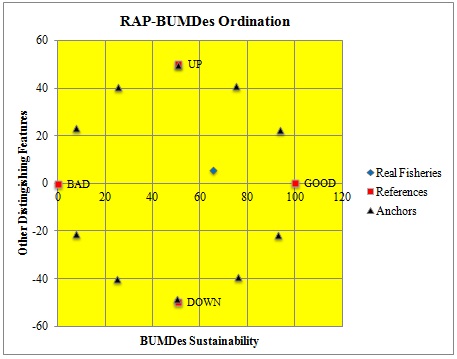 | Figure 4. Social Dimension Sustainability Index |
The social dimension sustainability index in the development of BUMDes can be seen above. Attributes on the social dimension give consideration of the influence on the level of sustainability of BUMDes development. Based on the results of the Rap-BUMDes analysis, it is known that the sustainable value of BUMDes development on the Social dimension is 65.29 and shows that the social dimension has a fairly sustainable status. The results of the Rap-BUMDes social dimension have fairly good analysis results because the stress value is 0.15 and the R2 value is 0.94, while the allowable stress value is not greater than 0.25 and the R2 value is not greater than 1.b. Analysis of leverage attributes on the social dimensionThe results of the analysis of leverage of attributes from the social dimension can be seen in the image below. | Figure 5. Analysis of Leverage Attributes Social Dimensions |
The Root Mean Square (RMS) value for each attribute in the social dimension can be seen in the table below.Table 2. RMS value in the analysis of leverage of attributes on the social dimension
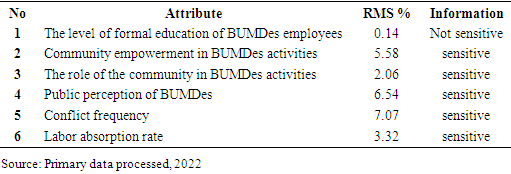 |
| |
|
Sensitive attributes are attributes that play a role in the sustainability status of the dimensions to be studied. In this result, the RMS value 2%, that is, all attributes of the social dimension. The influence of attributes that are sensitive and have a greater influence on the sustainability of BUMDes development are the frequency of conflicts, community perceptions of BUMDes, and empowerment of rural communities in BUMDes activities, where these three attributes have a very high RMS value compared to other attributes.c. Monte Carlo Analysis on the Social DimensionThe results of the Monte Carlo analysis on the social dimension of the sustainability status of BUMDes development can be seen in the image below.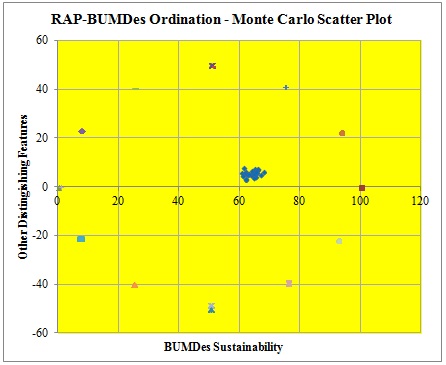 | Figure 6. Monte Carlo Analysis of Social Dimensions |
The Monte Carlo analysis of the position of the ordinance points that are close together shows that the results of 25 repetitions are in the range of values from 60.94 to 67.67.
4.3. Analysis of the Sustainability Status of BUMDes from Legal and Institutional Dimensions
a. Rap-BUMDes Ordination Analysis on Legal and Institutional DimensionsThe Legal and Institutional Dimensions consist of 6 sustainability attributes, including: Cross-sectoral cooperation in the development of BUMDes, Law enforcement against violations of BUMDes rules, Legal and Religious Instruments, Domination of certain political groups, Synchronization of central and regional policies, Compliance in carrying out existing rules on BUMDes. | Figure 7. Legal and Institutional Dimension Sustainability Index |
Based on the results of the Rap-BUMDes analysis, it is known that the sustainable value of BUMDes development on the legal and institutional dimensions is 55.11, which shows that the legal and institutional dimensions have a fairly sustainable status. The results of the Rap-BUMDes legal and institutional dimensions have fairly good analysis results because the stress value is 0.15 and the R2 value is 0.94, while the allowable stress value is not greater than 0.25 and the R2 value is not greater than 1.b. Leverage Attributes Analysis on Legal and Institutional DimensionsLeverage of attributes analysis on legal and institutional dimensions is used to determine which attributes have a significant influence on sustainability status in Jember Regency. The results of the analysis of the leverage of attributes from the legal and institutional dimensions can be seen in the image below.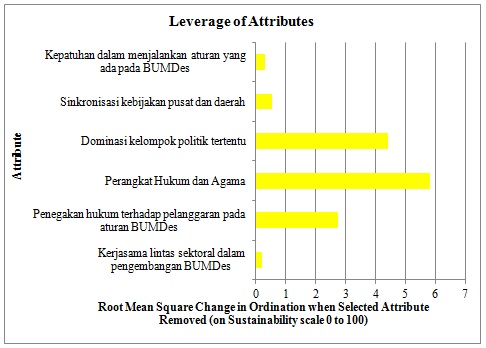 | Figure 8. Analysis of Leverage Attributes Legal and Institutional Dimensions |
The Root Mean Square (RMS) value for each attribute in the legal and institutional dimensions can be seen in the table below.Table 3. RMS value in the analysis of leverage of attributes on legal and institutional dimensions
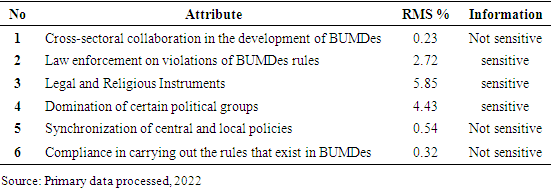 |
| |
|
Sensitive attributes are attributes that play a role in the sustainability status of the dimensions to be studied, where these attributes are able to encourage and hinder sustainability statusdevelopmentBUMDeson the legal and institutional dimensions. In this result, the RMS value 2%, that is, all the attributes of the legal and institutional dimensions. The influence of attributes that are sensitive and have a greater influence on the sustainability of the development of BUMDes are Legal and Religious Instruments, the dominance of certain political groups, and law enforcement against violations of BUMDes rules, where these three attributes have a very high RMS value compared to other attributes.c. Monte Carlo Analysis on Legal and Institutional DimensionsThe results of the Monte Carlo analysis on the legal and institutional dimensions of the sustainability status of BUMDes development can be seen in the image below. | Figure 9. Monte Carlo Analysis of Legal and Institutional Dimensions |
The monte carlo analysis of legal and institutional dimensions shows a fairly good result (no significant error range) as indicated by the collection of scatter plots resulting from the MDS repetition or ordinance points whose positions are close to each other as shown in the figure above. The position of the ordinance points that are close to each other shows that the results of 25 repetitions are in the value range of 52.48 – 56.69.
4.4. Analysis of the Sustainability Status of BUMDes from the Infrastructure and Technology Dimension
a. Analysis of the Rap-BUMDes Ordination on the Dimensions of Infrastructure and TechnologyThe Infrastructure dimension consists of 6 sustainability attributes, including: The existence of supporting facilities and infrastructure in the development of BUMDes, The existence of supervisory human resources in the development of BUMDes, The existence of BUMDes development programs and community empowerment, Standardization of Product Quality produced by BUMDes, Availability of Processing Industries, Availability of Information Technology.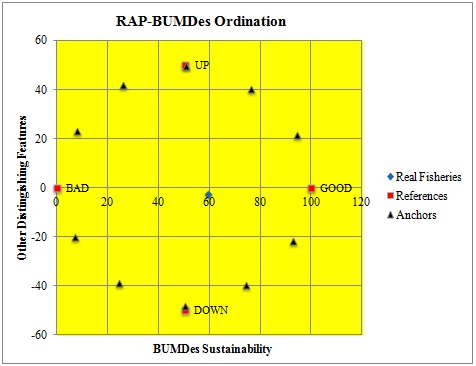 | Figure 10. Sustainability Index of Infrastructure and Technology Dimension |
Based on the results of the Rap-BUMDes analysis, it is known that the sustainable value of BUMDes development in the infrastructure and technology dimensions is 59.16 and shows that the infrastructure and technology dimensions have a fairly sustainable status. The results of the Rap-BUMDes dimension of infrastructure and technology have a fairly good analysis result because the stress value is 0.14 and the R2 value is 0.94, while the allowable stress value is not greater than 0.25 and the R2 value is not greater than 1.b. Analysis of leverage attributes on the Dimensions of Infrastructure and TechnologyThe results of the analysis of leverage of attributes from the dimensions of infrastructure and technology can be seen in the image below: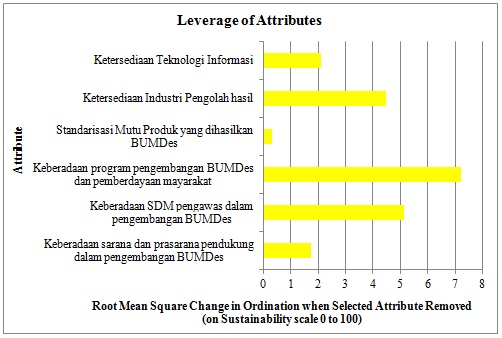 | Figure 11. Analysis of Leverage Attributes Dimensions of Infrastructure and Technology |
The Root Mean Square (RMS) value for each attribute in the infrastructure and technology dimensions can be seen in the table below.Table 4. RMS value in the analysis of leverage of attributes on the dimensions of infrastructure and technology
 |
| |
|
In this result, which has an RMS value of 2%, that is, all attributes of the dimensions of infrastructure and technology. The influence of attributes that are sensitive and have a greater influence on the sustainability of BUMDes development are the existence of BUMDes development programs and community empowerment, the existence of BUMDes development programs and community empowerment, and the availability of product processing industries, where these three attributes have a very high RMS value compared to the other attributes. other.c. Monte Carlo Analysis on the Dimensions of Infrastructure and TechnologyThe results of the Monte Carlo analysis on the dimensions of infrastructure and technology on the sustainability status of BUMDes development can be seen in the image below. | Figure 12. Monte Carlo Analysis of Infrastructure and Technology Dimensions |
The Monte Carlo analysis of the dimensions of infrastructure and technology shows quite good results (does not have a significant error range) as shown by collecting the scatter plots of the MDS repetition or ordinance points that are positioned close to each other as shown in the Figure above. The position of the ordinance points that are close together shows that the results of 25 repetitions are in the range of values from 55.74 to 60.45.
4.5. Sustainability Status of Multidimensional BUMDes Development
Sustainability status Sustainability status development BUMDes on the economic, social, legal & institutional and infrastructure & technology dimensions after being analyzed using the RAP-BUMDes. In each dimension, the results show as shown in table 5:Table 5. Results of Analysis of Sustainability Status development BUMDes on each dimension
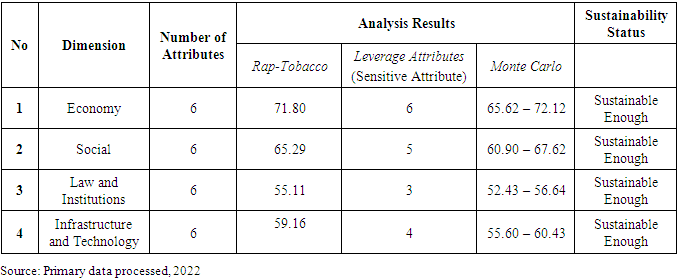 |
| |
|
The economic dimension has six sensitive attributes by showing results that are quite good or do not have a significant error range. This is indicated by the points of repetition of the Multidimensional Scaling (MDS) analysis that collect between the values of 65.66 and 72.14 or the ordinance point that is still within a position close to each other. The sustainability status on the social dimension shows the results of the Rap-BUMDes Ordination of 65.29, which means that the dimension is still in a fairly sustainable ordinance scale position. The social dimension has five sensitive attributes by showing results that are quite good or do not have a significant error range. This is indicated by the point of repetition of the Multidimensional Scaling (MDS) analysis, which collects between values 60.94 and 67.The sustainability status on the legal and institutional dimensions shows the results of the Rap-BUMDes Ordinance of 55.11, which means that the dimension is still in a fairly sustainable ordinance scale position. The legal and institutional dimensions have 3 sensitive attributes by showing fairly good results or not having a significant error range. This is indicated by the repeating point of the Multidimensional Scaling (MDS) analysis, which collects between the values 52.48-56.69 or the ordinance point that are still in close proximity to each other.The sustainability status on the infrastructure and technology dimensions shows the results of the Rap-BUMDes Ordination of 59.16, which means that the dimension is still in a fairly sustainable ordinal scale position. The dimensions of infrastructure and technology have four sensitive attributes by showing good results or not having a significant error range. This is indicated by the repeating point of the Multidimensional Scaling (MDS) analysis, which collects between the values of 55.74 and 60.45 or the ordinance point that are still in close proximity to each other.After the value of the sustainability status index in each dimension, namely, the economic, social, legal & institutional and infrastructure & technology dimensions has been known, the sustainability status index value can be depicted on the flyover diagram as follows: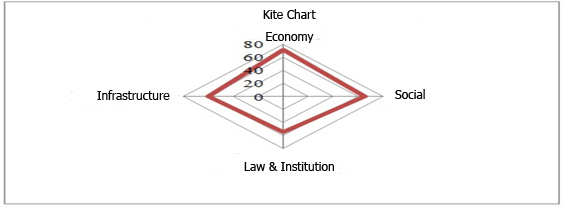 | Figure 13. Sustainability status index value development BUMDes with Kite Diagrams |
The results of the multidimensional analysis above show that the sustainability function of BUMDes in Jember Regency is in a moderately sustainable status with a sustainability status index value of 62.84. The value is on an ordinance scale of 60.01 – 75.00. In order to maintain and improve the sustainability status in the future, it is necessary to intervene (improve) the attributes that affect the improvement of the sustainability status.Regarding the sustainability of BUMDes business development, apart from the dimensional factors mentioned above, there are also governance factors of the institution. (Herman Cahyo, D. 2017). Furthermore, the results of the study explain that institutional governance is a key determinant of business success for each type of BUMDes. This is because each type of BUMDes business does not stand alone but has linkages with other factors that greatly affect business sustainability. This linkage is like a link and if this chain is broken, the efforts of the BUMDes will be affected. (Herman Cahyo, D. 2017).The findings of the current study (2022) indicate that there are other factors besides money that prevent BUMDes from developing, such as a lack of knowledge about local government, a lack of respect for employees, a lack of attention from the local government, and a lack of rewards for BUMDes employees. Another factor is the dominance of particular political groups. A delicate characteristic that plays a significant role in the frequency of violence is the dominance of particular political groupings. This is evident in the actual circumstances, when political factions dictate every policy or choice pertaining to the advancement and growth of BUMDes. This will complexed the growth and development of BUMDes.
5. Conclusions and Suggestion
The research authors offer a number of conclusions, including (1). The multidimensional sustainability role of BUMDes Jember Regency's sustainability status index value places it in the moderately sustainable category, indicating that all factors, including infrastructure and technology, as well as economic, social, legal, and institutional aspects, have an impact on the sustainability of BUMDes. (2). When compared to other factors, the economic dimension has the largest impact on the sustainability status of BUMDes (social, legal, and institutional, infrastructure, and technology). The chance to improve sustainability is greatest in the economic dimension, which has the highest sustainability index value. BUMDes.Furthermore, it offers the following suggestions: (1) In order to foster economic relationships that are mutually beneficial, village-owned businesses (BUMDes) must strengthen their economic collaboration with the community or other relevant stakeholders. (2). The sustainability status must be enhanced with sensitive qualities in order to preserve it in the future. Non-sensitive attributes must also be improved in order to allow for the improvement of sensitive attributes that affect BUMDes' sustainability status. (3). Prioritization must be given to improving sustainability dimension elements with lower sustainability index values, such as infrastructure, technology, and the legal and institutional dimensions. Future sustainability index values can be improved or maintained in terms of their economic and social dimensions.
ACKNOWLEDGEMENTS
This Research in Financially Suppprted by Grand DIPA UNEJ Tahun 2022, Institute For Research and Community Service, Universitas Jember.
References
| [1] | Adawiyah, R. (2018). Strategy for Development of Village Owned Enterprises (BUMDes) Based on Social Capital Aspects (Study on BUMDes Surya Sejahtera, Kedungturi Village, Taman District, Sidoarjo Regency). Journal of Public Policy and Management, 6(3), 1 – 15. |
| [2] | Bahareh Ansari, SM (2013). Sustainable Entrepreneurship in Rural Areas. Research Journal of Environmental and Earth Science, 26-31. |
| [3] | Coristya Berlian Ramadana, HR (2013). The Existence of Village Owned Enterprises (Bumdes) as Village Economic Strengthening (Study in Landungsari Village, Dau District, Malang Regency). Journal of Public Administration (JAP), 1(6), 1068-1076. |
| [4] | Dwiyanto, A. (1996). Reinventing Government: Main Thoughts and Their Relevance in Indonesia. Yogyakarta: Paper on Strategic Management Training for Hospital Director by Magister. |
| [5] | Herman Cahyo, D. Strategy for BUMDESA Institutional Development in Jember Regency. Journal of Economists L Journal of Economics and Development Studies Vol. 17 No. 2, 2017. |
| [6] | I Gede Agus Ariutama, AH (2017). The Role Of Village-Owned Enterprises (BUMDes) To Rural Development: A Comparative Institutional Analysis. Journal Of Regional Economic and Financial, 3(3), 59 – 65. |
| [7] | Nurmalina, R. (2008). Index Analysis and Sustainability Status of Rice Availability System in Several Regions of Indonesia. Journal of Agro-Economics, 26(1), 47 – 79. |
| [8] | Osborne, D.a. (1992). Reinventing Government: How The Entrepreneur Spirit is Transforming The Public Service Translated by Abdul Rosyid and Ramelan. Jakarta: Binaman Pressindo Library. |
| [9] | Prabowo, TH (2014). Developing BUMDes (Village-owned Enterprise) for Sustainable Poverty Alleviation Model Village Community Study in Bleberan-Gunung Kidul-Indonesia. World Applied Sciences Journal 30 (Innovation Challenges in Multidiciplinary Research & Practice), 19-26. |
| [10] | Putri Nugrahaningsih, FJ (2016). Optimization of Village Funds By Developing Village Owned Enterprises (Bum Des) Towards an Independent Village. Journal of Accounting and Business, 16(1), 37 – 45. |
| [11] | Ridlwan, Z. (2014). The Urgency of Village Owned Enterprises (Bumdes) in Village Economic Development. Fiat Justisia Journal of Legal Studies, 8(3), 424 – 440. |
| [12] | Sebastiana Viphindrartin, MD (2018). Potentials, Constraints and Sharia-Based Financing Models on Cassava Agroindustry BUMDes in Jember District. The International Journal of Social Sciences and Humanities Invention, 5(02), |
| [13] | Srirejeki, K. (2017). Empowering the role of village owned enterprises (BUMDes) for rural development: case of Indonesia. Journal of Accounting, Management, and Economics, 20(1), 5 – 10. |
| [14] | Wibowo Ab., AS (2015). Sustainability status of Ecological Dimensions in the Development of a Sustainable Minapolitan Area Based on Freshwater Aquaculture in Magelang Regency. Journal of Fisheries Science, 10(2), 107 – 113. |
| [15] | Zulhakim, H. &. (2017). The Existence of Village-Owned Enterprises (BUMDes) in Developing Business and Economics of Competitive Village Communities in the Era of the ASEAN Economic Community. ASEAN National Secretariat Journal, 1-13. |
















 Abstract
Abstract Reference
Reference Full-Text PDF
Full-Text PDF Full-text HTML
Full-text HTML



